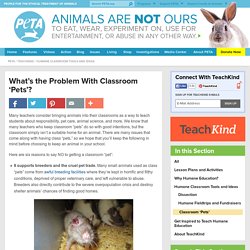

Pets in the Classroom from Pet Care Trust.mp4 [HD, 720p] Critters in the Classroom. Why dogs reduce stress in classrooms. Animals Make Good Teachers. Pets in the Classroom: KinderArt - K12 (For Teachers & Homeschoolers) Www.KINDERART.com Printer-Friendly Page Pets in the Classroom Written by: Andrea Mulder-Slater [Andrea is one of the creators of KinderArt.com] Pets are a wonderful source of happiness and inspiration.

Educators have used animals in the classroom for decades. From a goldfish filled aquarium to the hamster who roams the classroom floor in his roller ball, there is no doubt that critters are a great educational tool. An animal in the classroom creates improved learning experiences for your students as all areas of the curriculum are enhanced. If you are thinking of adding a pet to your classroom, please don't feel discouraged. Still interested? Here are the most popular classroom pets: turtles frogs hamsters gerbils guinea pigs rabbits spiders rats parrots crabs guppies goldfish lizards snakes More Information: © Andrea Mulder-Slater, KinderArt® © KinderArt ® | www.KinderArt.com. Port Angeles School Board to ban classroom pets. PORT ANGELES, Wash. - The Port Angeles School Board is banning classroom pets because of concerns that dogs, rabbits, snakes and baby chicks threaten student health and safety.

The Peninsula Daily News reports the board voted 4-1 in favor of the ban this week and will take a final vote at its June 11 meeting. “Why can’t we have a classroom gerbil?” Asked Sarah Methner, the lone board member who voted against the ban. "It's a nanny state gone wild. " But Lonnie Linn, board vice president and a member of the committee that created the wording for the new rule change, said a classroom gerbil is nothing more than a "varmint. " Superintendent Jane Pryne says the rule was prompted by complaints against a few teachers who let their dogs run in the hallways. But Linn says a review by legal and insurance teams found that almost any animal in a classroom is an unacceptable risk, especially for disease such as salmonella.
Under the pet ban, fish tanks and service animals would still be OK. Pass On the Classroom Pet. March 7, 2012 There are better ways to teach students about animals and responsibility The Humane Society of the United States Shevaun Brannigan/The HSUS Well-intentioned teachers often bring pets into the classroom to give their students lessons in respect, responsibility, and empathy for animals.

But from the animal’s perspective, this isn’t always the best option. Busy, noisy classrooms can be stressful, and small animals can be very adept at hiding symptoms of illness or injury (a lifesaving attribute when trying to avoid predators in the wild, but less than ideal in a setting where children are present). Small animals need large habitats that may not fit in the classroom, and many species need ample fresh produce daily. Even without a live animal present, lessons in responsible pet care and respect for all animals can still be a part of the classroom experience. Invite animal experts into the classroom Members of the community may be willing to speak to your students. Look Online. What's the Problem With Classroom 'Pets'?
Many teachers consider bringing animals into their classrooms as a way to teach students about responsibility, pet care, animal science, and more.

We know that many teachers who keep classroom “pets” do so with good intentions, but the classroom simply isn’t a suitable home for an animal. There are many issues that come along with having class “pets,” so we hope that you’ll keep the following in mind before choosing to keep an animal in your school. Here are six reasons to say NO to getting a classroom “pet”: It supports breeders and the cruel pet trade. Many small animals used as class “pets” come from awful breeding facilities where they’re kept in horrific and filthy conditions, deprived of proper veterinary care, and left vulnerable to abuse.
It’s unnatural. They’re left alone and left behind. There are better ways to teach. So What Can You Do?